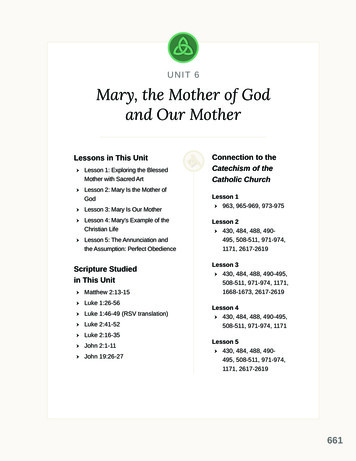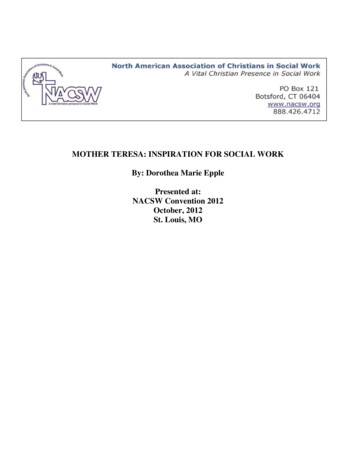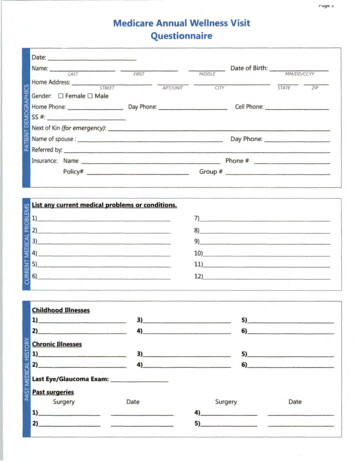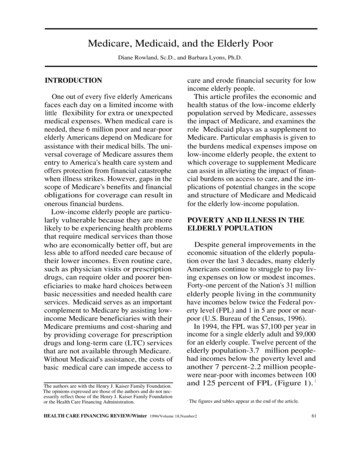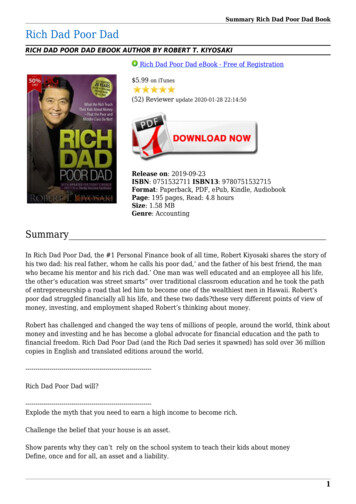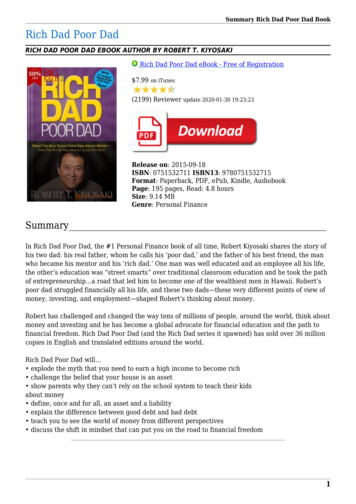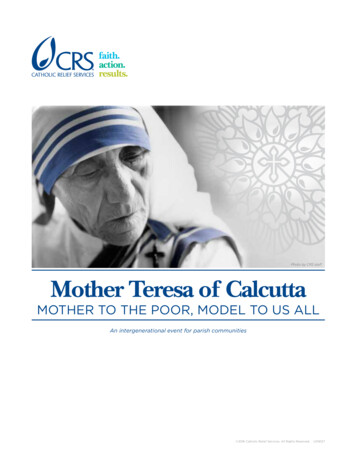
Transcription
Photo by CRS staffMother Teresa of CalcuttaMOTHER TO THE POOR, MODEL TO US ALLAn intergenerational event for parish communities 2016 Catholic Relief Services. All Rights Reserved.US16127
Mother to the Poor, Model to Us AllOBJECTIVES Learn about Mother of Teresa of Calcutta's story and witness of faith. Reflect on how we might also respond to Jesus’ invitation to serve him bycaring for the poor.MATERIALS Welcome: Welcome table with sign-in sheet Name tags and pens Icebreaker: Music player and speakers with background music of your choice Reflection stations: Copies of this guide for all volunteers leading stations Babysitting station: Age-appropriate toys, activities (like crayons and paper) Grades 1-5 station: Paper and coloring supplies Grades 6-8 station: Copies of “Option for the Poor and Vulnerable” activity sheet(see end of this document for the handout) Grades 9-12 station: Audio and video equipment; internet access; “CST 101: Option forthe Poor and Vulnerable” video from CRS’ YouTube channel Adult and young adult station: Audio and video equipment; internet access;“CST 101: Option for the Poor and Vulnerable” video from CRS’ YouTube channel Any items needed for the service activity (see Preparation section) Closing prayer: Review the Closing Prayer section in this document and set up the materials accordingly. Copies of the “Mother Teresa of Calcutta” handout from CRS' website Recording of “I Thirst” by Danielle Rose or alternate song Bible opened to Matthew 25:31-46 Crucifix Paper with the words “I thirst” written in big letters Large piece of butcher paper with the heading “Like Mother Teresa” writtenat the top. In rows beneath, write, “I will serve Christ in people who are poorby ” over and over as many times as will fit. Markers Table, cloth and a symbol from the service activity (like a sandwich or hygiene kit) Optional: Supplies for a potluck if you choose to end or begin the gathering with a mealMOTHER TERESA2
PREPARATIONAt least several weeks in advance: Read through this entire guide to decide which activities to include and howmany volunteers you’ll need. Double check which materials you’ll need. Recruit volunteers according to your needs (babysitters, 1-2 volunteers per station,volunteers to help with a meal if included). Promote the gathering. Include a notice in your church bulletin and pulpitannouncement. Speak about the event with parents of students in religiouseducation or at a table after Masses. Be sure to invite people personally! Plan your service activity for the charity station. It should be something simplethat can be done onsite with families, like sandwich making for a local soup kitchenor assembling hygiene packets for a homeless shelter. Contact a local communityorganization to find out what might be useful, and collect or ask participants tobring any needed supplies or donations. Optional: Sharing a potluck meal before or after the activity can help buildcommunity among participants. If you choose to do this, adjust the gatheringtime and ask participants to bring whatever food or items you need for the meal.The day before/of the event: Assess your available space and set up each of the stations either around one,large room or in various, smaller rooms within a building. Review the instructions for each station and the service activity andmake copies. Prepare all materials, activities and equipment. Prepare volunteers. Give each volunteer a copy of the instructions fortheir assigned station. Optional: Prepare anything needed for a potluck meal.MOTHER TERESA3
Mother to the Poor, Model to Us AllSESSIONOUTLINE welcome, prayer and icebreaker (25 minutes) Mother Teresa’s story (10 minutes) reflection stations (40 minutes: 30 minutes for theactivity, 5 minutes to transition to/from stations) charity station (25 minutes) closing prayer (15 minutes) optional: Add a potluck meal at the beginning or endof the session, and adjust timing as necessary. MOTHER TERESA4
welcome and prayer Invite each person to wear a name tag. Gather and welcome everyone. (10 minutes)Introduce the session: Mother Teresa’s canonization by Pope Francis is September 4, 2016. To be canonized means to bedeclared a saint! A saint is someone who lived a very holy life on Earth and who the Church believesis in heaven. We can ask the saints to pray for us in a special way. Today we will learn a little bitabout why Mother Teresa is being declared a saint and will reflect on how her example of holinessis a model for us all. We will spend some time together as a large group and in smaller groups ofchildren, teens and adults. To begin, we will offer a prayer and then give people the opportunity tomeet others whom they may not know.Lead the prayer:In the name of the Father, and of the Son, and of the Holy Spirit Mother Teresa of Calcutta,Your deep and abiding longing for GodDrove you to seek him in the faces of all you encountered,From the richest of the richTo the poorest of the poor.You taught us to find our full human dignityIn upholding the dignity of others:The sick and the outcast,The destitute and the dying.And all the world honored you with the title of Mother.Teach us still, Mother Teresa,For we too yearn for our Lord,Forgetting that he is all around us.We humbly beg your intercessionThat the Lord God may turn us from our indifference,Turn us from our fearAnd send us forthInto the depths of encounter,Into the fullness of compassionThat we may look upon our sisters and brothersIn the scandal of their suffering,And like you,Behold the face of our Savior.AmenMOTHER TERESA5
Mother Teresa with CRS staff, Sean Callahan, far left, and former CRS president, Ken Hackett, second from right.Photo by CRS stafficebreaker: playing favorites Give instructions:When the music begins, everyone should wander about the room. The music will suddenly stop.When it does, the leader will shout a number. Everyone must form a group with whomever isclosest. The number of people in the group must equal the number shouted. Once groups areformed, the leader will state a category, like color, food, cereal, season or type of music.Everyone will introduce themselves to the people in their group and share their favorite thingin the category. When the music starts again, people will roam around until the music stopsand the game is repeated.Begin playing the music.Mother Teresa’s story (5 minutes)(10 minutes)Invite everyone to sit down as you share Mother Teresa’s story. Explain that they should listencarefully to the story now and will have a chance to talk about it in small groups after.Optional: Depending on the size of your group and ages of people gathered, consider invitingelementary-aged children to act out the story as you read it. Choose people to play: Mother Teresa,students, a sick person, a person who doesn’t have enough to eat, and 2 Missionaries of Charity.and ask them to improvise their part as you read it.Read the story:Mother Teresa wasn’t always named Mother Teresa. She was born in 1910 into a regular family,like you or me, in modern day Macedonia in Southeast Europe. Her name was Anjezë, which isAgnus in English. When she was 18 years old, she felt called to be a nun, so she left home for Irelandand joined a religious order called the Sisters of Loreto. A nun will often choose a new name whenshe becomes a sister, and she took the name Sister Teresa, after St. Therese of Lisieux. She was sentto Calcutta, India, where she served as a teacher for many years.Calcutta is very poor. Sister Teresa could look out of the window of the school where she taughtand see many people on the streets who needed help. Some people did not have enough food toeat, others were sick and had no one to take care of them.MOTHER TERESA6
One day, when she was on a long train ride, SisterTeresa experienced a powerful moment of prayer. Sheheard Jesus asking her to leave the Sisters of Loreto totake care of the people who needed help on the streetsof Calcutta. She had no idea how she would do it, butshe knew she had to try. So she started out on her own.At first, she cared for the people she met on thestreets of Calcutta. She gave the hungry food, helpedtake care of the sick and spent time with peoplewho had no one to talk to. Within a few months, sheattracted followers.Some of the students from the school where shetaught came to help. These women were the first tojoin her new order of sisters, called the Missionariesof Charity. It was then that Sister Teresa becameMother Teresa, the founder of a new order.There are now 4,500 sisters working in countries allover the world! The Missionaries of Charity spend manyhours in prayer and service each day. Their prayer helpsthem remember that when they are caring for the poor,they are caring for Jesus who suffers. Jesus tells us thathe is present in the poor in a special way. The sisterslive very simply, without conveniences like washingmachines, microwaves or—in many of their convents—even beds, because part of their mission is to liveamong the poor.The Church in the United States has a specialrelationship with the Missionaries of Charity. CatholicRelief Services, which helps the poor overseas onbehalf of Catholics in the United States, worked withMother Teresa and her sisters since the early daysof the their ministry in Calcutta.Mother Teresa died in 1997, but she still inspires ustoday. She reminds us to not be afraid to answerJesus’ call, even when it means stepping outsideof our comfort zones. And her story also remindsus to notice and reach out to people who are in need. Photo by CRS staffAfter sharing the story, direct participants to theage-appropriate stations. Allow 5 minutes totransition from the large group to small groups.MOTHER TERESA7
reflection stations(30 minutes)BABYSITTING Provide age-appropriate activitiesfor younger children, includingcoloring and toys.GRADES 1-5 When children are gathered, ask: What do you remember from MotherTeresa’s story? Who did Mother Teresa want to help? How did she help them? Distribute paper and coloring supplies. Give instructions for an activity:Mother Teresa’s sisters serve Jesus byhelping people who are poor all aroundthe world. We can follow her exampleand do the same. This activity will helpus reflect on how we might do that. Foldyour paper in half. On one side, draw apicture of Mother Teresa helping someonein need. On the other half, draw a pictureof a way you have shown God's love tosomeone who needed help. If time permits, invite them to sharewhat they drew.GRADES 6-8 When the young people are gathered, ask: What do you remember from MotherTeresa’s story? Who did Mother Teresa want to help? Distribute the “Option for the Poor and Vulnerable” activity sheet. Give instructions for the activity:Photo by CRS staffMother Teresa learned a lot from the people she served. The activity sheet includes a story MotherTeresa once told. You will have a few minutes to complete the activity sheet on your own and thenwe will read the story aloud. Discuss the reflection questions on the activity sheet together.GRADES 9-12 When the young people are gathered, ask: Why did Mother Teresa leave the Sisters of Loreto? What about Mother Teresa’s story inspired you?MOTHER TERESA8
Explain:Mother Teresa devoted the second half of her life to serving the poorest of the poor. Her sisters,the Missionaries of Charity, continue this work today. In every one of their chapels around the world,the words “I thirst” are posted next to the crucifix. This reminds them that Jesus who thirsts onthe cross is the same Jesus who thirsts in the person without clean water to drink. We believe thatChrist is present in all people, especially the very poor. In Matthew 25:40, Jesus says that when wefeed the hungry, clothe the naked, give drink to the thirsty and welcome the stranger, we do all ofthese things for him. Introduce the “CST 101: Option for the Poor and Vulnerable” video:Mother Teresa’s love for the poor reminds us of God’s special love for the poor. And this isan important part of our Catholic faith. The video we will watch now is about the part of ourCatholic social teaching that emphasizes having a special love and concern for the poor. Ask: What challenged you or resonated with you from this video? Father James Martin, SJ, suggests that one way of caring for the poor is to getto know—or to “encounter”—people who are poor. This is what Mother Teresa did. What isone way you could or currently encounter the poor in your community? Why do you think encountering those who are poor is important? What are some ways we can serve the poor around the world? Do you think you are connected to or have any responsibility to care for people who arepoor overseas? Why or why not? Explain:Mother Teresa shows us that part of being a disciple of Jesus is to care for people who are pooraround the world. But it’s hard to care about people who feel so distant from us. Perhaps thePhoto by CRS staffMOTHER TERESA9
first step is to learn about people who are poor overseas and about the injustices facing peopleworldwide. Stay plugged into the news and follow organizations like Catholic Relief Services tohelp make sure the news about people in need is on your radar. Many of the images in the videoyou watched are from places where CRS works around the world. CRS works on behalf ofCatholics in the United States to relieve the suffering of poor and vulnerable people around. If youhave a smartphone, you can get started now by following @CatholicReliefon Twitter or Catholic Relief Services on Instagram.YOUNG ADULT AND ADULT When people are gathered, ask: What about Mother Teresa’s story surprised or inspired you? Mother Teresa experienced what she later described as a “call within a call.” What do you thinkthis means? Can you relate to it? Explain:Mother Teresa devoted the second half of her life to serving the poorest of the poor. Her sisters,the Missionaries of Charity, continue this work today. In every one of their chapels around theworld, the words “I thirst” are posted next to the crucifix. This reminds them that Jesus who thirstson the cross is the same Jesus who thirsts in the person without clean water to drink. We believethat Christ is present in all people, especially in the very poor. In Matthew 25:40, Jesus says thatwhen we feed the hungry, clothe the naked, give drink to the thirsty and welcome the stranger,we do all of these things to him. Introduce the “CST 101: Option for the Poor and Vulnerable” video:Mother Teresa’s love for the poor reminds us of God’s special love for the poor. And this isan important part of our Catholic faith. The video we will watch now is about the part of ourCatholic social teaching that emphasizes having a special love and concern for the poor. Ask: What resonated with you or challenged you from this video? Father James Martin, SJ, suggests that one way of caring for the poor is to get to know—or to “encounter”—people who are poor. This is what Mother Teresa did. What is one wayyou could or currently do encounter the poor in your community? Explain:Many of the images in the video are from places where Catholic Relief Services works around theworld. CRS is the official humanitarian agency of the Catholic community in the United States andworks in more than 100 countries. Mother Teresa worked closely with CRS when she was alive andthe Missionaries of Charity continue to collaborate with CRS around the world. One way we can liveout Mother Teresa’s legacy—and the witness of Christ—is by helping the poor. How can we do this?Here are two ideas:1. Buy fair trade products, which are made ethically and ensure that the people overseas makingthe products were paid fairly and worked in safe conditions. Visit crsfairtrade.org.2. Use your power to advocate for people in need overseas. CRS and the United States Conferenceof Catholic Bishops have a legislative advocacy network called Catholics Confront Global Poverty,which provides updates about how to advocate with your lawmakers on issues that affect peopleliving in poverty. Sign up to receive texts from CCGP only when urgent action is needed. Getstarted now by taking out your phone and texting “Global” to 30644.Note to facilitator: To ensure all groups finish around the same time, the leader can give a5-minute warning to each group. All groups should reassemble in the main gathering space.Allow 5 minutes for people to transition from their small groups back to the larger group.MOTHER TERESA10
charity station(30 minutes) Set up your charity station in a large space in the main room (see Preparation section). Once everyone has gathered back together, explain:Mother Teresa’s order is called the Missionaries of Charity because they show charity by helpingmeet peoples’ immediate needs, like food and shelter. Today you will participate in an act ofcharity together. Introduce the activity. Give instructions about the service you will do together and who it will benefit.closing prayer (15 minutes)Make sure the prayer space includes a crucifix, paper with the words “I thirst,” and asymbol from your service activity set at the front of the room.Hang the “Like Mother Teresa” poster on a wall that people can access or put it on the floorin the front of the room. Scatter markers around it. Cue “I Thirst” by Danielle Rose or another appropriate song. Distribute copies of the “Mother Teresa of Calcutta” handout downloaded from CRS' website. Invite someone to be ready to read Matthew 25:31-46 during the prayer. Gather everyone together.LEADER:In the name of the Father, and of the Son and of the Holy Spirit,Jesus, who hungers and thirsts in the poor,Mother Teresa served you by caring for the poorest of the poor. In every one of their chapelswhere her sisters work around the world today, the words “I thirst” are posted next to the crucifix.This reminds the sisters that the Jesus who thirsts on the cross is the same Jesus who thirsts inthe poor because he doesn’t have clean water to drink. In the Gospels you tell us that whateverwe do for people who thirst, who are hungry, who are sick—we do directly for you.READER:A reading from the Gospel of Matthew:“When the Son of Man comes in his glory, and all the angels with him, he will sit upon hisglorious throne, and all the nations will be assembled before him. And he will separate themone from another, as a shepherd separates the sheep from the goats. He will place the sheep onhis right and the goats on his left. Then the king will say to those on his right, ‘Come, you whoare blessed by my Father. Inherit the kingdom prepared for you from the foundation of the world.For I was hungry and you gave me food, I was thirsty and you gave me drink, a stranger and youwelcomed me, naked and you clothed me, ill and you cared for me, in prison and you visited me.’Then the righteous will answer him and say, ‘Lord, when did we see you hungry and feed you, orthirsty and give you drink? When did we see you a stranger and welcome you, or naked and clotheyou? When did we see you ill or in prison, and visit you?’ And the king will say to them in reply,‘Amen, I say to you, whatever you did for one of these least brothers of mine, you did for me.’Then he will say to those on his left, ‘Depart from me, you accursed, into the eternal fire preparedfor the devil and his angels. For I was hungry and you gave me no food, I was thirsty and you gaveme no drink, a stranger and you gave me no welcome, naked and you gave me no clothing, ill andin prison, and you did not care for me.’ Then they will answer and say, ‘Lord, when did we see youhungry or thirsty or a stranger or naked or ill or in prison, and not minister to your needs?’ He willMOTHER TERESA11
answer them, ‘Amen, I say to you, what you did not do for one of these least ones, you did not dofor me.’ And these will go off to eternal punishment, but the righteous to eternal life.”The Gospel of the Lord.RESPONSE: Praise to you, Lord Jesus Christ.LEADER:Lord, we thank you for the witness of Mother Teresa, who saw you in your “most distressingdisguise of the poorest of the poor,” and did not turn her back. We pray that we, too, mightserve you by serving people who are poor.We will take a moment now to quietly reflect on one thing we can do to attend to Christ in the poor,either in our local or global community. Maybe it’s as simple as saying “hi” to someone we see everyday. Or, perhaps we will make a commitment to staying better informed about, and getting involvedwith, the work that our Church is doing to care for the poor overseas. As the music plays, take amarker and finish the sentence, “I will serve Christ in people who are poor by .”Play “I Thirst” by Danielle Rose or another reflective song.When everyone has had a chance to write something, gather all together. Invite those who arecomfortable to share the sentence they wrote aloud. When sharing is finished, ask everyone toread the prayer on their handout together:Mother Teresa of Calcutta,On the train to DarjeelingYou heard what so many human hearts long to hear:The voice of God.Through the seed of his Word,You built a movement the world has rarely seenAnd so longs for,A movement of mercy,A movement of compassion,A movement of hope shining in the darkest places.And in each of your sisters’ chapels around the world,There hangs a crucifix:The suffering, dying ChristAnd the words, “I thirst.”These words are a call to action.We gaze upon your exampleWalking off the safe pathTo risk all in doing the will of the LordFor the poorest of the poor.And we hear the agonizing cry of the one who called upon you: “I thirst.”Have we too not heard the voice of God?Mother Teresa, you know our hearts,Crying for the one who cries for us.And as we respond to this cryIn our prayers and in our works,We ask your intercession:Mother Teresa of Calcutta, pray for us.AmenMOTHER TERESA12
option for the poor and vulnerableACTIVITY SHEET GRADES 6–8Using the box below, complete Mother Teresa’s story. Once you’ve completed themissing words, take the first letter of each word and unscramble it to discoverwhat we can show to people in need everywhere.ANSWER:“ night, a man came to our house to tell me that a Hindu family, a familyof eight children, had not eaten anything for days. They had nothing to eat. I tookenough rice for a meal and went to their house. I could see the hungry faces, thechildren with their bulging eyes. The sight could not have been more dramatic!The mother took the rice from my hands, divided it in half and went out. Whenshe came back a little later, I asked her: ‘Where did you go? What did you do?’She , ‘They also are hungry.’ ‘They’ were the peoplenext door, a Muslim family with the number of children to feed andwho did not have any food either. That was aware ofthe . She had the courage and the love toshare her meager of rice with .In spite of her , I think she feltMISSING WORDS:Answeredcircumstancesvery happy to share with her the little I hadtaken her. order not to take away her happiness, I did not take her anymorerice that night. I took her some more the following day.”— From Mother Teresa: In My Own Words, by José Luis Gonzalez-BaladoInmotherneighborsQUESTIONS FOR REFLECTIONWere you surprised by the generosity displayed by people who were in such greatneed themselves? Why or why not?OneothersportionsamesituationHow can you show for the poorand vulnerable?
MOTHER TERESA 3 PREPARATION At least several weeks in advance: Read through this entire guide to decide which activities to include and how many volunteers you'll need. Double check which materials you'll need. Recruit volunteers according to your needs (babysitters, 1-2 volunteers per station, volunteers to help with a meal if included).



